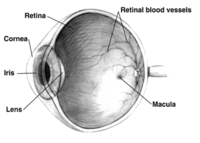Retina
This relies largely or entirely on a single source. |
The retina is the thin neural tissue that contains light sensitive neurons called photoreceptors (rods and cones) that interact with secondary and tertiary neurons inside the eyeball in humans and in many animals. Its role is to sense the light which gets into the eye and send information about it to the brain.

Most information about light images that leaves the retina travels through the optic nerve, and is used by the brain to create visual sensations. Information about light which travels through the retino-hypothamalic tract is for adjusting circadian rhythms to the 24-hour day.
The center of the human retina, called the fovea centralis, or just fovea, has the most [cone cells] for sensing bright colors and fine detail of a viewed object. Even though the fovea takes up only 1.5 square millimeters, it plays the most important role in vision. It is only around 1% of the human retina, but the fovea sends about as much information to the visual cortex as the rest of the retina combined. [1]
Additional images
change-
The structures of the eye labeled
-
Another view of the eye and the structures of the eye labeled
-
Illustration of image as 'seen' by the retina independent of optic nerve and striate cortex processing
References
change- ↑ Kolb, Helga; Nelson, Ralph; Fernandez, Eduardo; Jones, Bryan. webvision.med.utah.edu. e-book Moran Eye Center, University of Uta. pp. The Architecture of the Human Fovea.